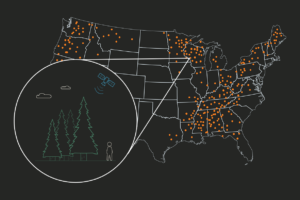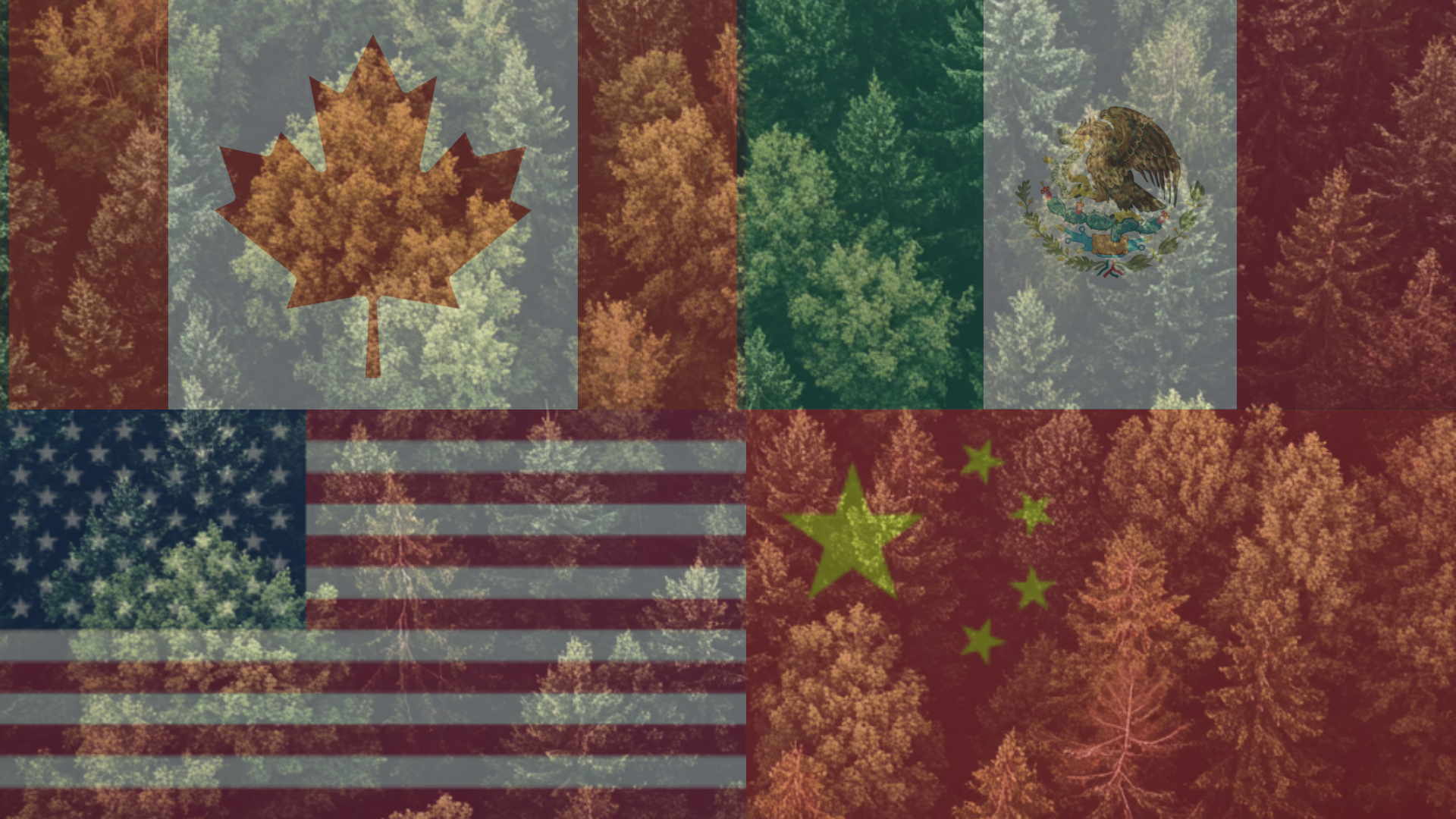Introduction
The recent threat of tariffs by the U.S. on imports from Canada, Mexico, and China has introduced a wave of uncertainty across various industries and forestry is no exception. Tariffs, which are essentially taxes on imported goods, can have far-reaching effects on both the supply chain and market dynamics. While these policies aim to protect domestic industries, their ripple effects can create both opportunities and challenges for forest landowners, depending on local market conditions and the types of trees in their forests.
Understanding Tariffs
Tariffs increase the cost of imported goods, making them less competitive compared to domestic products. This can benefit local producers by reducing foreign competition, but it can also lead to higher prices for end consumers. Economists broadly view tariffs as inflationary due to this, especially when domestic supply cannot match market demand for products. Also, the potential of retaliatory tariffs or other trade restrictions threaten tens of billions of dollars in forest product exports from the U.S. We’ll dive into important context on the trade dynamics between Canada, Mexico, China, and the United States and how tariffs may affect you as a forest landowner.
Potential Impacts on Forest Landowners
The effects of these tariffs will vary depending on the type of forest products landowners produce and their local market conditions:
- Softwood Producers: May benefit from higher demand and prices for saw timber caused by reduced competition from Canadian lumber. While domestic saw timber demand may increase, the downward pressure on the pulp and paper market will remain a pervasive challenge for forest landowners in the U.S. Southeast. Tariffs will not solve the broader challenges facing this market. Effects will be highly dependent on local market dynamics like proximity to mills, mill capacity, and the demand for new wood coming into those mills. This is further complicated by the fact that thousands of new homes will need to be rebuilt following devastating fires throughout the American West.
- Hardwood Producers: Could suffer from reduced export demand, leading to lower prices. Mill infrastructure in the Northeast is also generally aged and stressed so any further disruption to their ability to sell economically could harm the overall viability of their businesses.
- Mixed Forests: Landowners with diverse forest products may experience a mix of positive and negative impacts, depending on their specific product portfolio and market exposure.
Important Context on Trade
The U.S. engages in substantial trade of forest products with Canada, Mexico, and China with these three countries filling the top 3 spots for forest product exports and spots 1, 2, and 4 for forest product imports. While the dynamics of each trade arrangement are unique, tariffs are likely to affect all. Over half of the $38.1 billion in forest product exports that the U.S. did in 2023 went to these three nations.1
Canada: Forest products have been a hot topic in trade negotiations between Canada and the United States for decades. The long-standing softwood lumber dispute between the U.S. and Canada offers insight into how such trade conflicts can evolve. Historically, these disputes have led to increased prices and market volatility. The U.S. heavily relies on Canadian softwood lumber, which accounts for roughly 25% of U.S. consumption. While the U.S. is one of the largest global exporters of timber products, the demand for lumber to support the domestic construction industry has led to consistent import reliance on Canadian softwood lumber. Since the expiration of the 2006 Canada-U.S. Softwood Lumber Agreement in 2016, duties have been applied to Canadian lumber imports. The current combined rate stands at 14.4%, and a 25% tariff could raise this to 39.4%, significantly impacting costs in sectors like new home construction.2 This also could damage the overall financial viability of some Canadian softwood mills, prompting questions about the long term health of the softwood lumber market as more mills close. The U.S. also exports massive amounts of timber to Canada, with over $10B in trade volume in 2023 alone, ranking them as our #1 export partner for wood products, especially products derived from American hardwoods. Retaliatory tariffs could threaten this substantial export volume. Tariffs on crude oil that’s imported from Canada and refined in the US into diesel may also impact the cost and viability of harvest operations especially in places like the Intermountain West.
Mexico and China: The U.S. exports a considerable amount of forest products to China and Mexico, ranking them as #2 and #3 on for total exports in the sector respectively. Demand from China has been decreasing since the demand spike following the COVID pandemic and low interest rate environment that followed. Retaliatory tariffs from these countries on forest products could further reduce demand, affecting options and profitability of U.S. producers. The U.S. also imports crude oil from Mexico. Similar to Canada, if diesel fuel prices increase due to lower imported supply, conducting harvest operations may become more expensive.
The State of the U.S. Timber Market
The U.S. timber market has been in a state of general uncertainty since the end of the COVID construction boom as interest rates have risen. In the U.S. South, the timber market faces an oversupply challenge. The average pine growth-to-drain ratio was 1.4 in 2024, indicating that timber growth outpaced harvest levels.3 The popularity of southern yellow pine planting starting 30-40 years ago paired with aging or closing mill infrastructure has led to many overly dense forests in the region, making it harder for landowners to sell, especially small diameter trees bound for pulp and paper mills. Large investments in pulp and paper infrastructure in Brazil coupled with lower overall consumption of paper products like newspapers has tipped the scales even further. This imbalance has exerted downward pressure on pulpwood prices in the region. In the coming years, this challenge is likely to continue, though the potential for new demand from biomass powerplants in the Southeast could offer signs of hope for small diameter trees. British power company Drax announced plans to invest up to $12.5 billion in biomass plants with carbon capture and storage (BECCS) in the United States over the next decade. These plants have a long road to being operational, though.
2024 was marked by a series of mill closures across the United States, primarily due to high operational costs and a weak market.
Notable closures include:
- Interfor Corporation: Indefinitely curtailed operations at its sawmills in Meldrim, Georgia, and Summerville, South Carolina, in August 2024.
- West Fraser: Announced the indefinite curtailment of its Lake Butler, Florida, sawmill by the end of September 2024, affecting approximately 130 employees.
- Stimson Lumber Company: Closed its Plummer, Idaho, facility in August 2024, citing ongoing industry pressures.
- Weyerhaeuser: Shut down its sawmill in New Bern, North Carolina, in November 2024.
Why this matters:
The Canadian, Mexican, Chinese, and U.S. economies are very intertwined and trade policies like tariffs have the potential of creating significant challenges across the forest products supply chain.
- Reduced demand from foreign markets may lead to more mill closures, especially for certain markets that are already running on razor thin margins and have millions of dollars backlogged operational expenses.
- Higher softwood lumber prices, while they may benefit some forest landowners, when combined with elevated interest rates could further dampen new home construction, the main demand source for domestic softwood.
- If diesel prices increase as a result of tariffs, this would also have an impact on the cost and viability of harvests for loggers, who consume large amounts of diesel for harvesting equipment and trucking.
Conclusion
While tariffs are designed to protect domestic industries, their broader economic impacts can introduce significant uncertainty. For forest landowners, understanding these dynamics is crucial. NCX helps landowners make informed decisions about their portfolio of Natural Capital Assets, including timber. We can help you make decisions about what to do with your forest assets based on your unique goals. Create a free account and set up a consultation with one of our advisors if you would like personalized advice.



